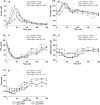Selection for feed efficiency elicits different postprandial plasma metabolite profiles in response to poor hygiene of housing conditions in growing pigs
- PMID: 33780478
- PMCID: PMC8006997
- DOI: 10.1371/journal.pone.0246216
Selection for feed efficiency elicits different postprandial plasma metabolite profiles in response to poor hygiene of housing conditions in growing pigs
Abstract
This study was conducted to compare postprandial plasma concentrations of insulin, energy-related metabolites, and amino acids measured after a 6-week challenge consisting of exposure to good or poor hygiene of housing conditions of 24 growing pigs divergently selected for low-RFI (LRFI) and high-RFI (HRFI). Blood indicators of immune responses were assessed from samples collected before 0 (W0), and 3 (W3), and 6 weeks (W6) after pigs transfer to their respective hygiene of housing conditions. Plasma haptoglobin concentrations and blood neutrophil granulocyte numbers were greater in poor than in good hygiene of housing conditions at W3. Plasma concentrations of total immunoglobulin G were greater (p = 0.04) in poor than in good hygiene of housing conditions at W6. At W6, pigs were fitted with an intravenous catheter for serial blood samplings. Low-RFI pigs had greater insulin (p < 0.001) and lower triglyceride (p = 0.04) average plasma concentrations than HRFI pigs in both conditions. In poor hygiene of housing conditions, the peaks of insulin and glucose were observed earlier and that of insulin was greater in LRFI than in HRFI pigs. Irrespective of genetic line, average plasma concentrations of histidine, isoleucine, leucine, methionine, threonine, valine, and alanine were greater in poor compared with good hygiene of housing conditions. Only HRFI pigs had greater lysine, asparagine, proline, and tyrosine plasma concentrations in poor than in good hygiene of housing conditions. Conversely, arginine, tryptophan, proline, and tyrosine plasma concentrations were lower only for LRFI pigs housed in poor hygiene conditions. Our results suggest that, contrary to HRFI, LRFI pigs increase or maintain their utilization of tryptophan, arginine, and lysine when housed in poor hygiene conditions. This indicates that this difference may contribute to the better capacity of LRFI to cope with poor hygiene of housing conditions.
Conflict of interest statement
The authors have declared that no competing interests exist.
Figures



Similar articles
-
A blend of functional amino acids and grape polyphenols improves the pig capacity to cope with an inflammatory challenge caused by poor hygiene of housing conditions.BMC Vet Res. 2023 Jan 30;19(1):25. doi: 10.1186/s12917-023-03580-w. BMC Vet Res. 2023. PMID: 36717823 Free PMC article.
-
Impact of hygiene of housing conditions on performance and health of two pig genetic lines divergent for residual feed intake.Animal. 2018 Feb;12(2):350-358. doi: 10.1017/S1751731117001379. Epub 2017 Jun 27. Animal. 2018. PMID: 28651668
-
Identification of blood immune and metabolic indicators explaining the variability of growth of pigs under contrasted sanitary conditions.BMC Vet Res. 2021 Apr 15;17(1):166. doi: 10.1186/s12917-021-02872-3. BMC Vet Res. 2021. PMID: 33858408 Free PMC article.
-
Poor hygiene of housing conditions influences energy metabolism in a muscle type-dependent manner in growing pigs differing in feed efficiency.Sci Rep. 2022 May 14;12(1):7991. doi: 10.1038/s41598-022-12050-6. Sci Rep. 2022. PMID: 35568703 Free PMC article.
-
Effects of divergent selection for residual feed intake on nitrogen metabolism and lysine utilization in growing pigs.J Anim Sci. 2020 May 1;98(5):skaa152. doi: 10.1093/jas/skaa152. J Anim Sci. 2020. PMID: 32367123 Free PMC article.
Cited by
-
A blend of functional amino acids and grape polyphenols improves the pig capacity to cope with an inflammatory challenge caused by poor hygiene of housing conditions.BMC Vet Res. 2023 Jan 30;19(1):25. doi: 10.1186/s12917-023-03580-w. BMC Vet Res. 2023. PMID: 36717823 Free PMC article.
-
Effects of the Inclusion of Dietary Bitter Gourd (Momordica charantia) on the Performance and Carcass Characteristics of Pigs: Potential Application in the Feed Chain.Animals (Basel). 2023 Jun 30;13(13):2159. doi: 10.3390/ani13132159. Animals (Basel). 2023. PMID: 37443956 Free PMC article.
-
Increased Dietary Trp, Thr, and Met Supplementation Improves Performance, Health, and Protein Metabolism of Weaned Piglets under Mixed Management and Poor Housing Conditions.Animals (Basel). 2024 Apr 9;14(8):1143. doi: 10.3390/ani14081143. Animals (Basel). 2024. PMID: 38672291 Free PMC article.
-
Effects of β-Mannanase Alone or Combined with Multi-Carbohydrase Complex in Corn-Soybean Meal Diets on Nutrient Metabolism and Gut Health of Growing Pigs.Animals (Basel). 2024 Nov 29;14(23):3457. doi: 10.3390/ani14233457. Animals (Basel). 2024. PMID: 39682426 Free PMC article.
-
Hygiene of housing conditions and proinflammatory signals alter gene expressions in porcine adipose tissues and blood cells.PeerJ. 2022 Dec 13;10:e14405. doi: 10.7717/peerj.14405. eCollection 2022. PeerJ. 2022. PMID: 36530394 Free PMC article.
References
-
- Knap PW. Voluntary feed intake and pig breeding. In: Tollardona D, Roura E, editors. Voluntary feed intake in pigs. Wageningen Academic Publishes, Wageningen; 2009. pp. 13–31.
Publication types
MeSH terms
LinkOut - more resources
Full Text Sources
Other Literature Sources

